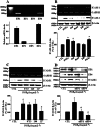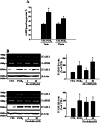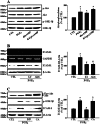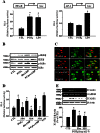Prostaglandin E₂-induced intercellular adhesion molecule-1 expression is mediated by cAMP/Epac signalling modules in bEnd.3 brain endothelial cells
- PMID: 23317035
- PMCID: PMC3682708
- DOI: 10.1111/bph.12103
Prostaglandin E₂-induced intercellular adhesion molecule-1 expression is mediated by cAMP/Epac signalling modules in bEnd.3 brain endothelial cells
Abstract
Background and purpose: Prostaglandin E₂ (PGE₂) has been implicated in the regulation of adhesion molecules, leukocyte adhesion and infiltration into inflamed site. However, the underlying mechanism therein involved remains ill-defined. In this study, we explored its cellular mechanism of action in the regulation of the intercellular adhesion molecule-1 (ICAM-1) expression in the brain endothelial cells.
Experimental approach: bEnd.3 cells, the murine cerebrovascular endothelial cell line and primary mouse brain endothelial cells were treated with PGE₂ with or without agonists/antagonists of PGE₂ receptors and associated signalling molecules. ICAM-1 expression, Akt phosphorylation and activity of NF-κB were determined by reverse transcription polymerase chain reaction (RT-PCR), immunoblot analysis, luciferase assay and immunocytochemistry.
Key results: PGE₂ significantly up-regulated the expression of ICAM-1, which was blocked by EP4 antagonist (ONO-AE2-227) and knock-down of EP4. PGE₂ effects were mimicked by forskolin, dibutyryl cAMP (dbcAMP) and an exchange protein directly activated by cAMP (Epac) activator (8-Cpt-cAMP) but not a protein kinase A activator (N⁶-Bnz-cAMP). PGE₂-induced ICAM-1 expression was reduced by knock-down of Epac1. A PI3K specific inhibitor (LY294002), Akt inhibitor VIII (Akti) and NF-κB inhibitors (Bay-11-7082 and MG-132) attenuated the induction of ICAM-1 by PGE₂. PGE₂, dbcAMP and 8-Cpt-cAMP induced the phosphorylation of Akt, IκB kinase and IκBα and the translocation of p65 to the nucleus and increased NF-κB dependent reporter gene activity, which was diminished by Akti.
Conclusion and implications: Our findings suggest that PGE₂ induces ICAM-1 expression via EP4 receptor and Epac/Akt/NF-κB signalling pathway in bEnd.3 brain endothelial cells, supporting its pathophysiological role in brain inflammation.
© 2013 The Authors. British Journal of Pharmacology © 2013 The British Pharmacological Society.
Figures








Similar articles
-
Prostaglandin E(2) inhibits IL-18-induced ICAM-1 and B7.2 expression through EP2/EP4 receptors in human peripheral blood mononuclear cells.J Immunol. 2002 May 1;168(9):4446-54. doi: 10.4049/jimmunol.168.9.4446. J Immunol. 2002. PMID: 11970988
-
Prostaglandin E2 enhances interleukin-8 production via EP4 receptor in human pulmonary microvascular endothelial cells.Am J Physiol Lung Cell Mol Physiol. 2012 Jan 15;302(2):L266-73. doi: 10.1152/ajplung.00248.2011. Epub 2011 Nov 11. Am J Physiol Lung Cell Mol Physiol. 2012. PMID: 22080750
-
Endogenous prostaglandin E2 amplifies IL-33 production by macrophages through an E prostanoid (EP)2/EP4-cAMP-EPAC-dependent pathway.J Biol Chem. 2017 May 19;292(20):8195-8206. doi: 10.1074/jbc.M116.769422. Epub 2017 Mar 24. J Biol Chem. 2017. PMID: 28341741 Free PMC article.
-
cAMP signalling in the vasculature: the role of Epac (exchange protein directly activated by cAMP).Biochem Soc Trans. 2014 Feb;42(1):89-97. doi: 10.1042/BST20130253. Biochem Soc Trans. 2014. PMID: 24450633 Review.
-
Regulation of the inflammatory response of vascular endothelial cells by EPAC1.Br J Pharmacol. 2012 May;166(2):434-46. doi: 10.1111/j.1476-5381.2011.01808.x. Br J Pharmacol. 2012. PMID: 22145651 Free PMC article. Review.
Cited by
-
Pericytic porters: helping leptin step in.Trends Endocrinol Metab. 2021 Dec;32(12):958-959. doi: 10.1016/j.tem.2021.08.001. Epub 2021 Aug 19. Trends Endocrinol Metab. 2021. PMID: 34420855 Free PMC article.
-
Oxidative Stress and the Use of Antioxidants in Stroke.Antioxidants (Basel). 2014 Jul 3;3(3):472-501. doi: 10.3390/antiox3030472. Antioxidants (Basel). 2014. PMID: 26785066 Free PMC article. Review.
-
Poldip2 controls leukocyte infiltration into the ischemic brain by regulating focal adhesion kinase-mediated VCAM-1 induction.Sci Rep. 2021 Mar 10;11(1):5533. doi: 10.1038/s41598-021-84987-z. Sci Rep. 2021. PMID: 33692398 Free PMC article.
-
Endothelial Dysfunctions in Blood-Brain Barrier Breakdown in Alzheimer's Disease: From Mechanisms to Potential Therapies.CNS Neurosci Ther. 2024 Nov;30(11):e70079. doi: 10.1111/cns.70079. CNS Neurosci Ther. 2024. PMID: 39548663 Free PMC article. Review.
-
The Role of Endothelial L-PGDS in the Pro-Angiogenic and Anti-Inflammatory Effects of Low-Dose Alcohol Consumption.Cells. 2024 Dec 5;13(23):2007. doi: 10.3390/cells13232007. Cells. 2024. PMID: 39682755 Free PMC article.
References
-
- Aktan S, Aykut C, Oktay S, Yegen B, Keles E, Aykac I, et al. The alterations of leukotriene C4 and prostaglandin E2 levels following different ischemic periods in rat brain tissue. Prostaglandins Leukot Essent Fatty Acids. 1991;42:67–71. - PubMed
-
- Aloisi F, De Simone R, Columba-Cabezas S, Levi G. Opposite effects of interferon-gamma and prostaglandin E2 on tumor necrosis factor and interleukin-10 production in microglial: a regulatory loop controlling microglia pro- and anti-inflammatory activities. J Neurosci Res. 1999;56:571–580. - PubMed
Publication types
MeSH terms
Substances
LinkOut - more resources
Full Text Sources
Other Literature Sources
Miscellaneous

